The landscape of work is undergoing a seismic shift driven by rapid technological advancements, particularly in artificial intelligence (AI), automation, and digital transformation. According to the World Economic Forum’s “Future of Jobs Report 2023,” these changes are not only reshaping existing job roles but also creating new opportunities and challenges for workers and employers alike. Insights from various sources, including Gartner’s analysis of future work trends, provide a comprehensive view of these evolving dynamics.
The Technological Transformation of the Workforce
The World Economic Forum’s report highlights that 77% of organizations expect significant workforce changes over the next five years due to technological advancements. AI and automation are central to this transformation, with 75% of organizations either using or planning to use AI technologies. These developments are redefining job roles and the skills required in the modern workforce.
Gartner’s insights complement this perspective by noting several key trends shaping the future of jobs. Hybrid work models are becoming more prevalent as organizations adapt to changing worker expectations and technological capabilities. The integration of advanced AI tools into daily work processes is increasing, reflecting a broader trend toward digital transformation.
Largest job decline in millions
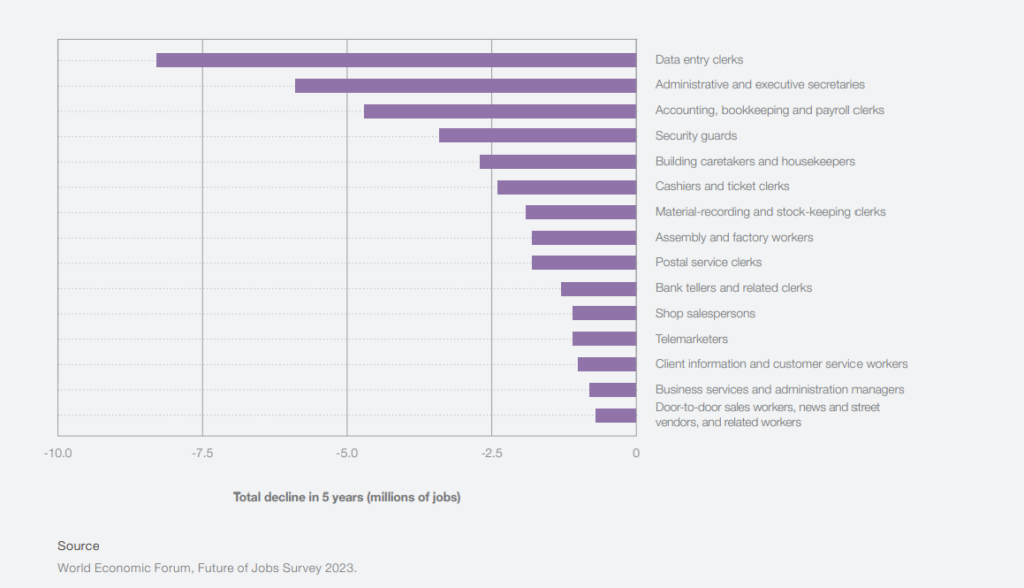
Emerging Job Roles and Skills
As technology advances, new job roles are emerging, reflecting the shifting needs of the workforce. The World Economic Forum identifies several key areas where demand is growing:
AI Specialists and Machine Learning Engineers: The need for professionals who can develop and manage AI technologies is increasing. These roles focus on designing algorithms and optimizing Machine Learning systems.
Data Analysts and Data Scientists: The ability to interpret and utilize data is becoming more crucial. Data analysts examine data to uncover trends and insights, while data scientists use advanced techniques to build predictive models and extract deeper insights.
Cybersecurity Experts: With the rise of digital systems, protecting against cyber threats is more critical than ever. Cybersecurity experts are tasked with safeguarding data and ensuring compliance with security regulations.
Digital Marketing Specialists: The digital marketing field is evolving, with a growing emphasis on leveraging AI and analytics to optimize campaigns and engage with audiences effectively.
These emerging roles align with broader trends identified by experts, including the increasing reliance on AI and digital tools, which are expected to redefine job functions and skill requirements (check: skill matrix).
Largest job growth in millions
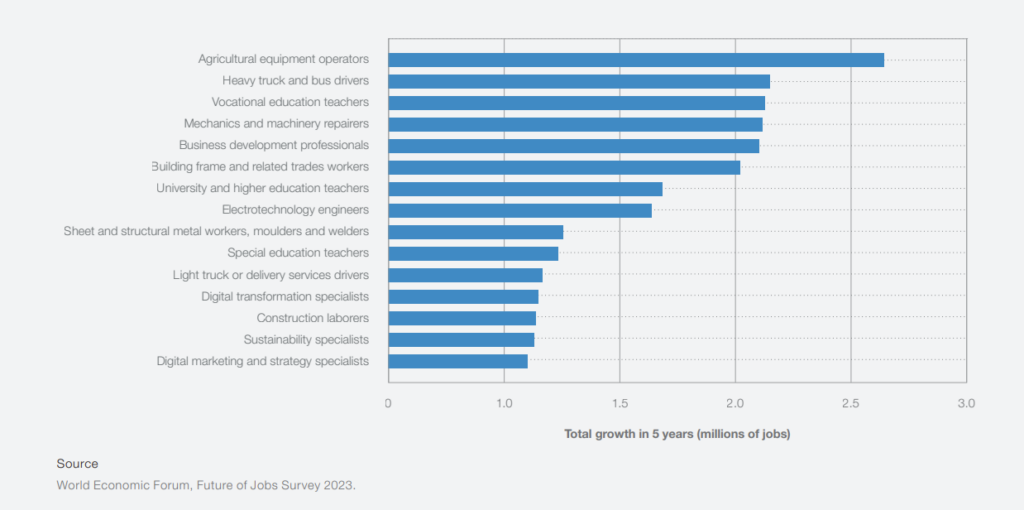
LinkedIn jobs on the rise 2018-2022
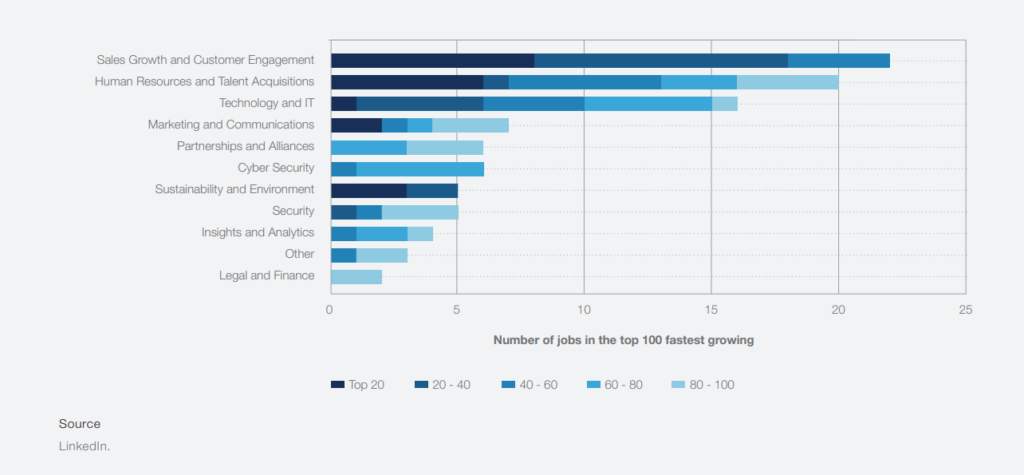
The Impact on Employment
Technology is expected to create new job opportunities while also leading to job displacement. The World Economic Forum estimates that approximately 40% of workers will need to reskill or upskill to remain relevant. Gartner’s insights also highlight the need for significant investment in reskilling and upskilling initiatives as organizations prepare their workforces for future changes.
Job displacement is a key concern, particularly for roles involving routine tasks that are increasingly automated. Reskilling and upskilling programs are essential to address these challenges. Organizations must invest in training that enhances both technical skills related to emerging technologies and soft skills such as problem-solving and critical thinking.
Fastest growing job postings on LinkedIn 2018-2022
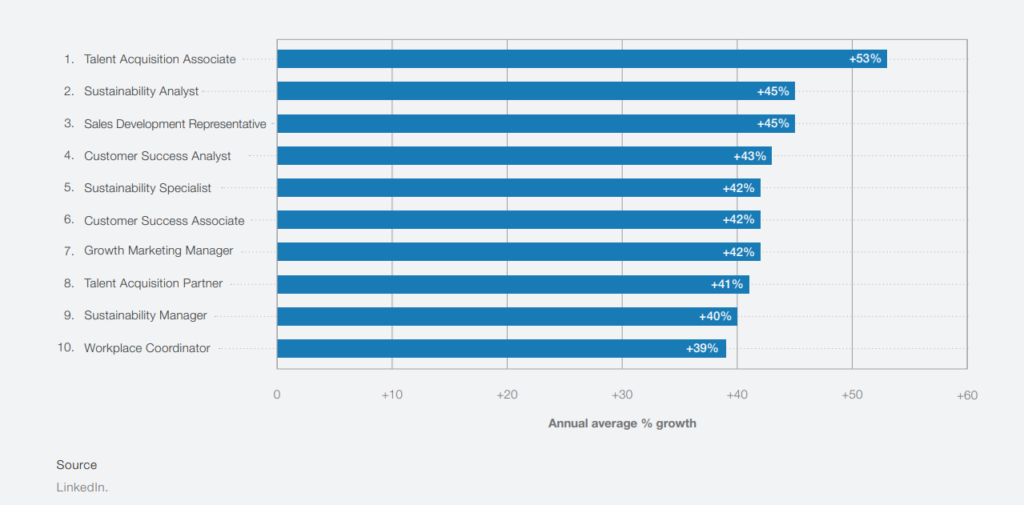
Reskilling and Upskilling: A Strategic Approach
To manage the transition effectively, a strategic approach to reskilling and upskilling is crucial. The World Economic Forum reports that 60% of organizations are already investing in training programs. This aligns with broader trends observed by experts, who emphasize the importance of these initiatives in preparing workforces for the future.
Corporate Training Programs: Many organizations are developing tailored in-house training programs to address specific skills gaps. These programs often focus on emerging technologies and provide employees with the necessary tools to stay current with industry trends.
Partnerships with Educational Institutions: Collaborating with universities and training providers helps ensure that educational programs align with industry needs. These partnerships can enhance curriculum development and better prepare graduates for the evolving job market.
Government Initiatives: Public programs aimed at reskilling and upskilling can offer workers access to training opportunities and financial support. Governments may provide subsidies for training programs, tax incentives for companies investing in employee development, or support for job transitions through vocational training and counseling on creating career development plans.
Online Learning Platforms: The growth of online learning platforms makes it easier for individuals to access training resources. Platforms such as Coursera and LinkedIn Learning offer courses in areas like data science and digital marketing, allowing individuals to acquire new skills at their own pace.
Future of Jobs: Macrotrends driving business transformation
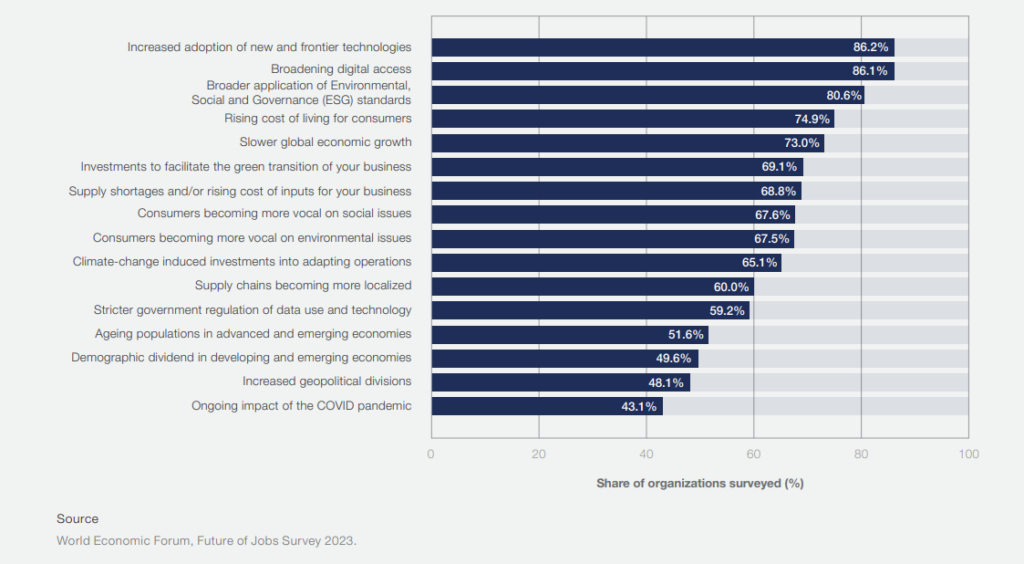
The Human Element: Fostering a Culture of Adaptability
Beyond technical training, fostering a culture of adaptability and continuous learning is essential for navigating the future of work. The World Economic Forum highlights the growing importance of soft skills such as resilience, creativity, and emotional intelligence. These skills are increasingly valued as technology reshapes job roles.
Encouraging a Growth Mindset: Organizations should promote a growth mindset among employees, framing reskilling and upskilling as opportunities for development. This approach helps employees embrace change and stay motivated.
Leadership and Support: Effective leadership is critical in managing workforce transitions. Leaders should clearly communicate the vision for technology adoption, provide support throughout the change process, and address employee concerns proactively. Offering resources for mental health and well-being, and creating a supportive environment can facilitate smoother transitions.
Employee Engagement: Engaging employees in the reskilling process is vital for success. Organizations should involve employees in discussions about technological impacts on their roles and seek their input on the skills they need. Providing opportunities for exploration and recognizing efforts can enhance motivation and engagement.
The Future of Work Trends
Broadly speaking, emerging work trends point towards a more flexible and technologically integrated workplace. Hybrid work models, increasing focus on employee experience, and the adoption of advanced AI tools are all key factors driving the evolution of job roles and workforce expectations. As organizations adapt to these trends, the emphasis will likely continue to be on integrating new technologies while fostering a supportive and adaptable work environment.
Technology adoption 2023-2027
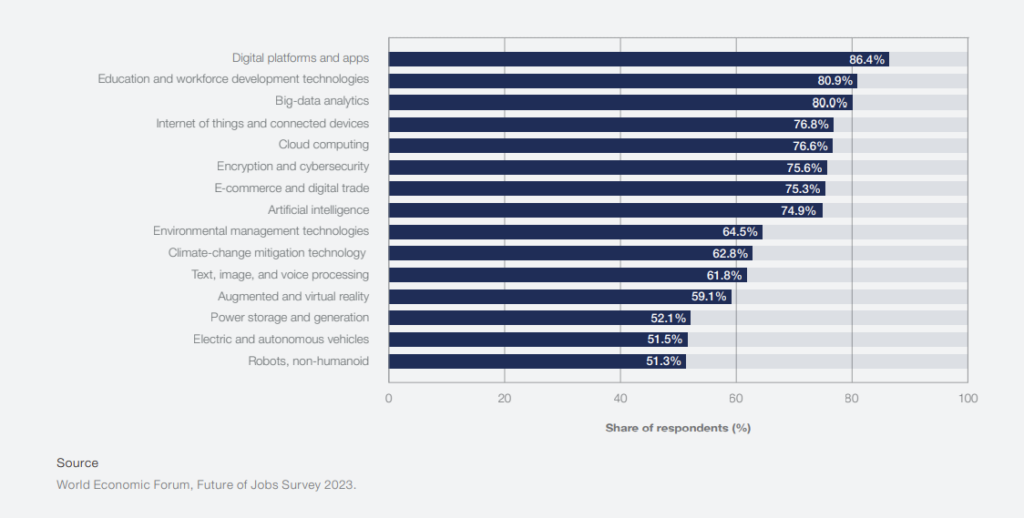
Future of Jobs: A Conclusion
The impact of technology on the workforce is profound and far-reaching. While automation and AI are expected to lead to job displacement in certain sectors, they will also create new opportunities for those with the right skills. Reskilling and upskilling are critical for managing this transition, and both organizations and governments play vital roles in supporting these efforts.
By focusing on technical and soft skills, fostering a culture of continuous learning, and investing in comprehensive training programs, organizations can prepare their workforces for the future. Embracing these changes with a strategic approach will help turn the challenges of technological disruption into opportunities for growth and innovation. The future of jobs is not a distant reality but an imminent transformation, and with thoughtful planning and execution, both individuals and organizations can thrive in this new era of work.
Engage an LMS For The Future Workforce Training
Reskilling and upskilling are essential to staying competitive, and organizations need to invest in continuous learning and training programs focused on both technical and soft skills. A Learning Management System will prepare your workforce for this transformation by providing personalized learning paths, accessible training, and skills development opportunities.
Learn how an LMS can help your organization thrive in the new era of work. Try a free Samelane LMS demo now:











